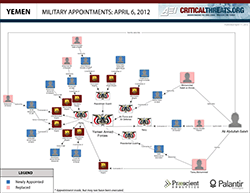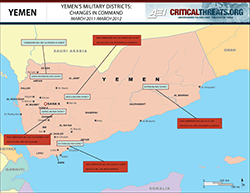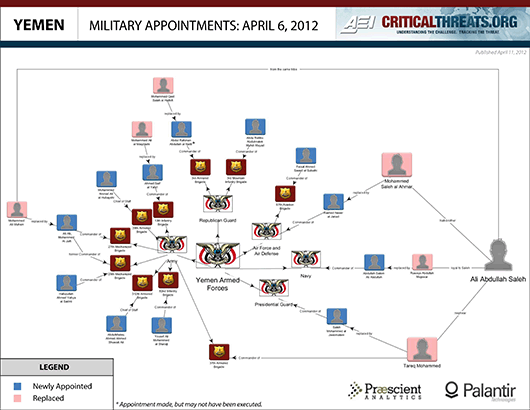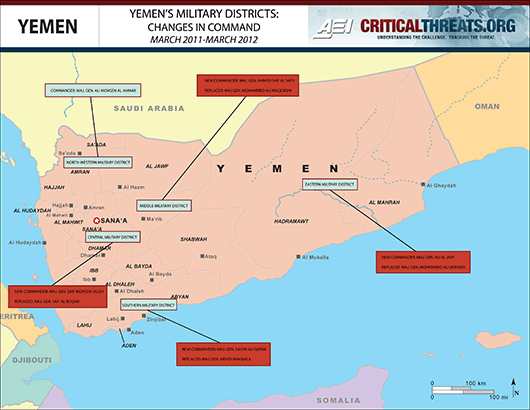{{currentView.title}}
April 12, 2012
Yemen's Military Shake-Up: Weakening Ousted Saleh's Network
American counterterrorism strategy in Yemen relies on the local military to contain Ansar al Sharia, an insurgent wing of al Qaeda in the Arabian Peninsula (AQAP).[1] But Yemen is losing ground to Ansar al Sharia, which has expanded its foothold in southern Yemen. Newly-elected President Abdu Rabbu Mansour Hadi must unify the fractured armed forces under his command; he has begun to do so by dismissing select commanders loyal to former President Ali Abdullah Saleh. Hadi’s success or failure in restructuring the Yemeni military will have dangerous implications for the country’s ability to prevail against Ansar al Sharia and AQAP, thought to be al Qaeda’s most dangerous branch, and thereby America’s ability to effect its security interests in the region.
President Hadi released a list of military and political appointments on April 6, 2012 that strikes at Saleh’s patronage network. Some of the holdover military commanders had reportedly acted to handicap the fight against Ansar al Sharia and destabilize the Hadi government.[2] The decrees removed Saleh’s half-brother and nephew from command positions and rearranged leadership in the Army and Navy. But Saleh figures remain in positions of power, most notably Saleh’s son Ahmed, head of the elite Republican Guard.
Restructuring the military is a pillar of the Gulf Cooperation Council (GCC) deal of November 2011, which dictates that the government must “integrate the armed forces under unified, national and professional leadership.”[3] The GCC announced its support for the appointments the day after their issue, saying that they complied with the terms of the GCC deal.[4]
The backlash from Saleh’s men has already affected the military. Mohammed Saleh al Ahmar, dismissed commander of the Air Force, threatened to shoot down planes at Sana’a airport.[5] Armed men loyal to Saleh shut down the Sana’a airport for a day. Rumors of other commanders refusing the changes have surfaced since the decrees.[6] It is unclear how the military will weather this unrest; its strength has already been sapped by a year of defections and mutiny. It is crucial to U.S. interests that Hadi bring the armed forces to bear, because without a unified Yemeni military, the fight against AQAP will fail.
Military Appointments
The April 6 decrees included the removal of former President Ali Abdullah Saleh’s half-brother Mohammed al Ahmar and nephew Tareq Mohammed Saleh from command of the Air Force and Presidential Guard respectively, along with several brigade commanders. But key figures, including Saleh’s son, remain in high military positions.
Military Districts
Yemen’s Armed Forces are divided into five military districts corresponding to geographical regions of the country. The commanders of these districts oversee several brigades and military camps, and are high in the military command structure. Over the past year, four of the five district commanders have been removed from their offices. The only commander to keep his post is defected Major General Ali Mohsen al Ahmar of the North-Western Military District.
The command of all of these districts presents critical challenges to the Yemeni military, and the Southern Military District is one of the most turbulent of the five. There, Ansar al Sharia, AQAP’s insurgent arm, seized territory and attacked military bases. President Abdu Rabbu Mansour Hadi dismissed the commander of the Southern Military district, Major General Mehdi Makwala--accused of attempting to destabilize Hadi’s government by hindering the military operation—in March.




